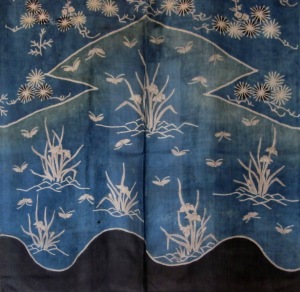Woman’s veil (katsugi or kazuki)
Silk
Paste resist, hand painted
The veil has a long and interesting history in Japan, and can be traced back to the Heian period. Initially, its purpose was to obscure the faces of women of high birth from the gaze of others while in public, but it also served to protect against insects and dust. When the katsugi tradition died out (for all intents and purposes around 100 years ago), it was worn mostly in the less densely populated areas, for such ceremonies as weddings and funerals. Over time, it changed from being an attachment worn around a hat to being a separate accessory shaped very much like a kimono, with vestigial sleeves. Some also have a deeply cut neckline to accomodate upswept hairdos (as shown here).
Mingei, the magazine of The Japan Folk Crafts Museum, states that in the Edo period, katsugi were outlawed in Edo (present day Tokyo) and Kyoto, in one of an endless series of sumptuary laws designed to limit lavish spending. Additionally, the book Beyond the Tanabata Bridge: Traditional Japanese Textiles notes that “In the city of Edo, the use of kazuki was banned … following an incident in 1652 in which an unemployed young samurai disguised himself under a kazuki and attempted to assassinate a high-ranking adviser to the shogun.”
This silk katsugi looks very much like the acclaimed Shonai katsugi. Shonai (present day Yamagata) was one of the outlying regions where the katsugi tradition remained strong, since it was unaffected by the various bans. Shonai katsugi are characterized by indigo grounds, large central crests, and horizontal strips of paste resist designs. Since Shonai did not have a large sericulture industry, and cotton did not grow well in northern Japan, Shonai katsugi were made of readily available hemp, and developed their own distinctive style. The fact that this katsugi is made of silk raises questions about its geographical origin.
The large crest on this katsugi indicates where the crown of the wearer’s head would be. Worn correctly, most of the wearer’s face would be obscured by the collar. Photo below found on Pinterest at Traditional Kimono, and originated at Trocadero.com.





What is the size of this veil? It’s difficult to have a sense of scale in the photograph. Thanks so much for sharing.
I was not familiar with this type of garment. so thank you for that bit of history. a lovely piece. also has me thinking of sumptuary laws.